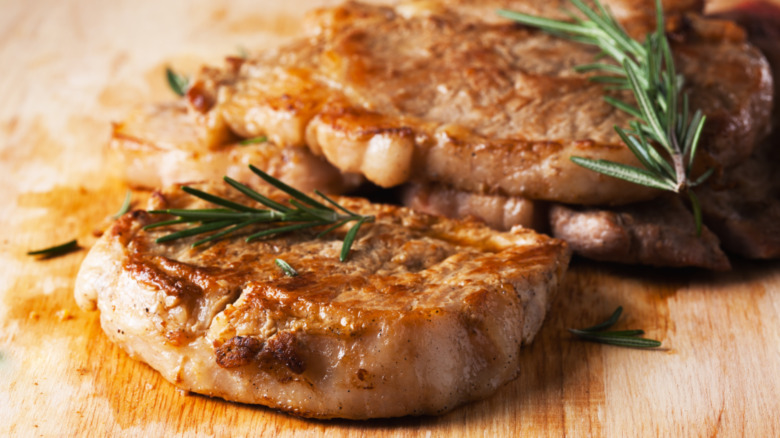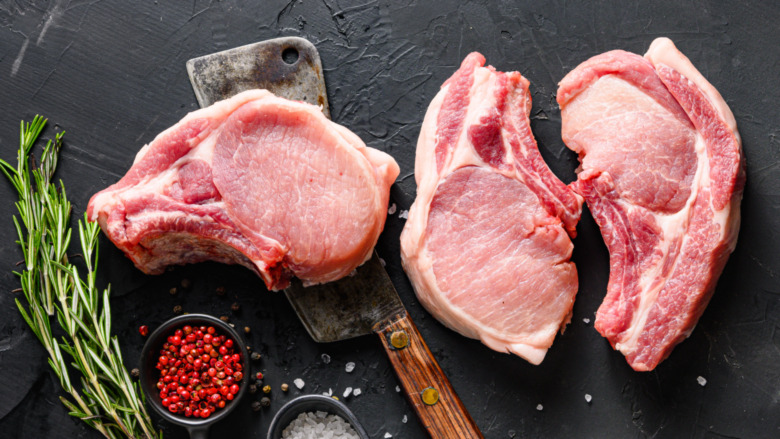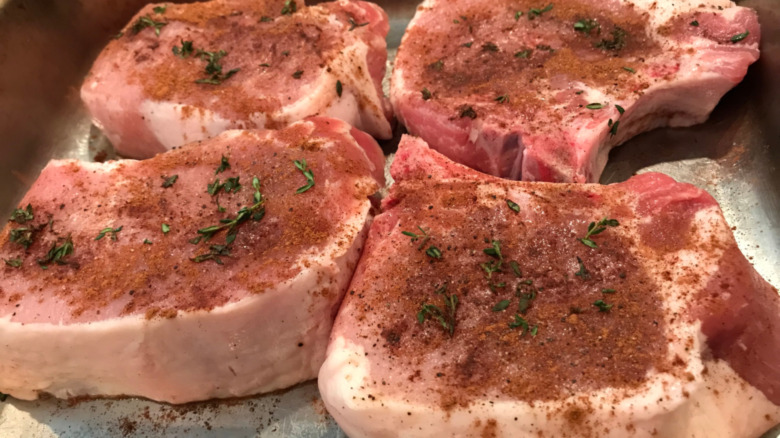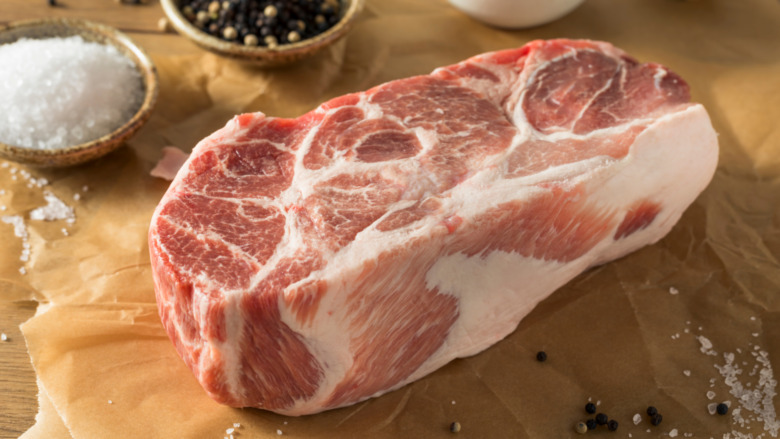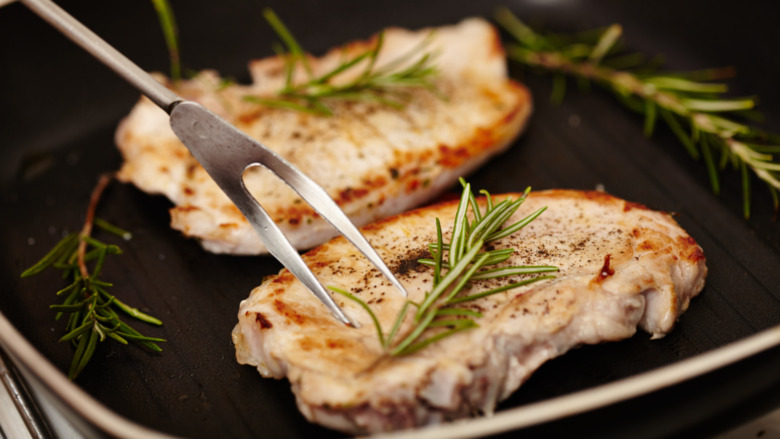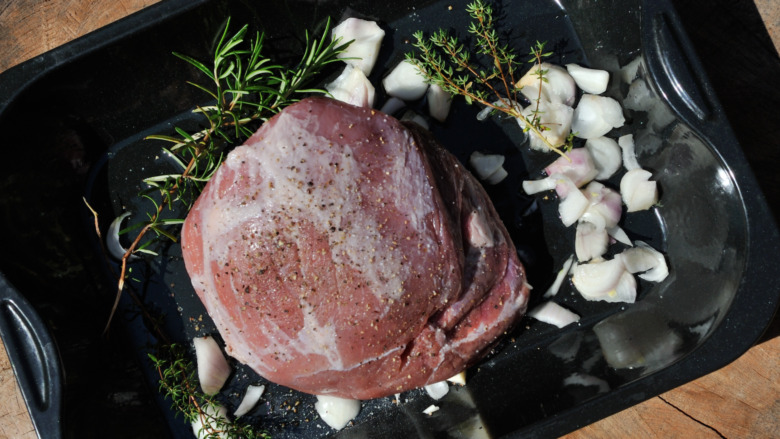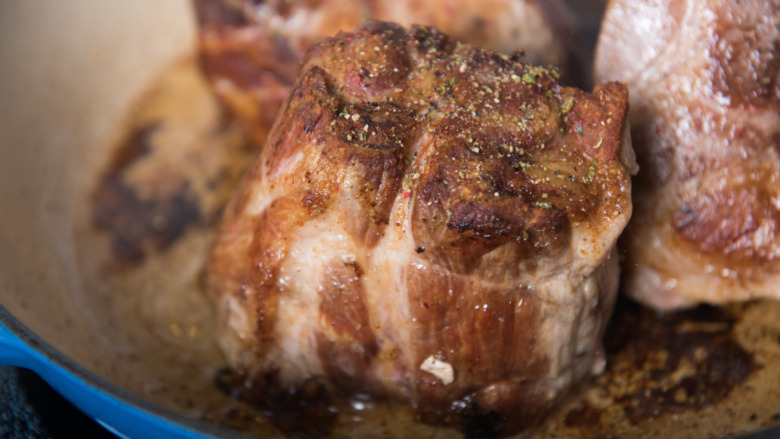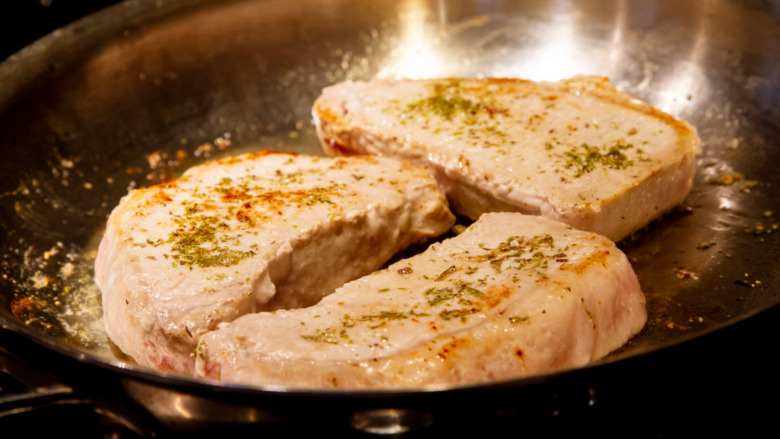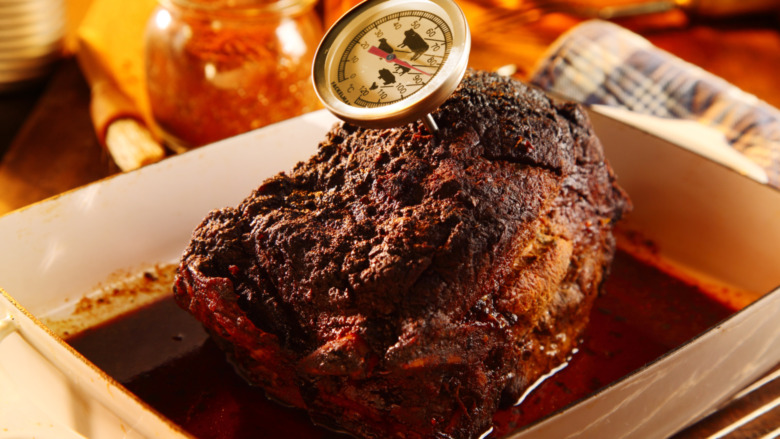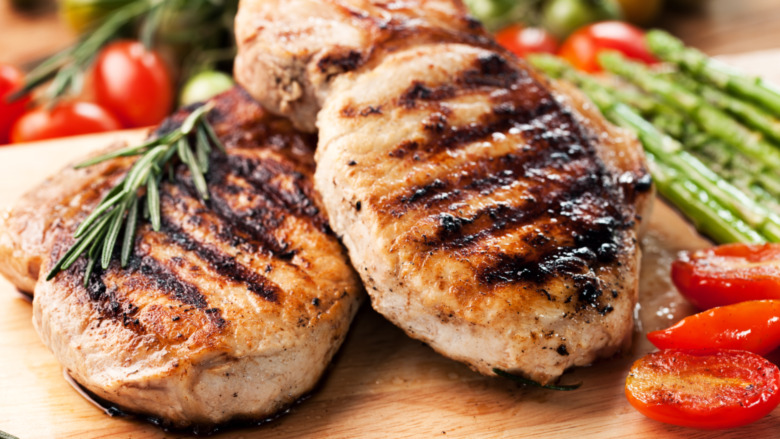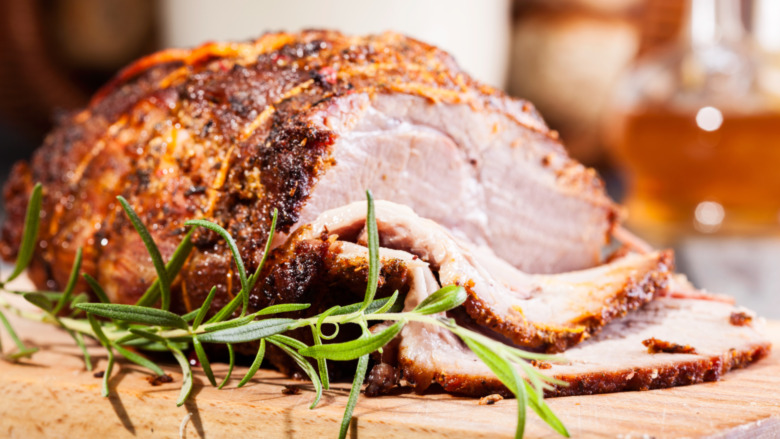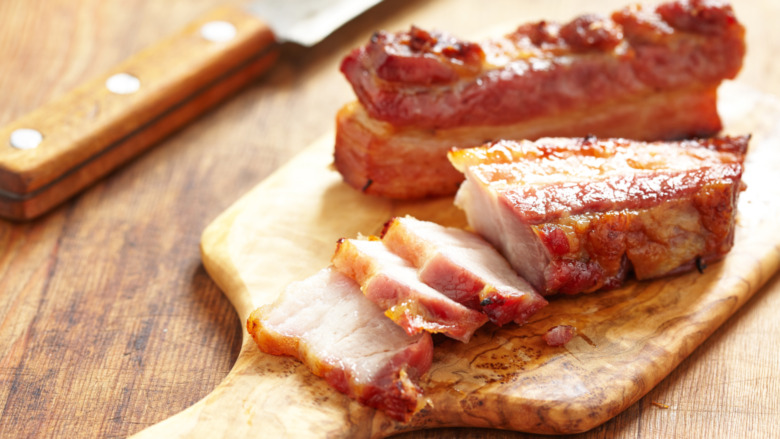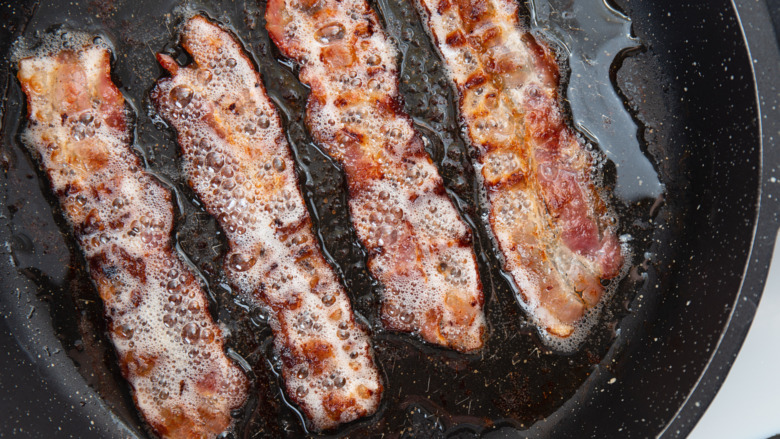Big Mistakes Everyone Makes When Cooking Pork
Pork is a prized protein for different reasons. It comes in a variety of different forms, with nearly endless ways to prepare all those different cuts of meat. Think roasted tenderloins, grilled chops, slow-braised pulled pork, smoked ribs, glazed ham, crispy bacon, and the list goes on. Are you hungry yet? We thought so. That's why pork is such an easy crowd-pleaser, to the point where you'll often find it the star of holiday tables and summer cookouts, as well as on your weekly shopping list.
Of course, all those culinary possibilities also mean a lot of room for error when cooking with pork. From the cut you choose, to the way you season it, to the temperature you're cooking it at, there are right and wrong ways to prepare good pork. And if you're gonna do it, might as well go whole hog, as they say, right? So make sure to avoid these common mistakes when cooking with pork and you'll wind up with a juicy, flavorful piece of meat every time.
Choosing the wrong cut of pork
The first mistake you can make with pork starts at the very first step: choosing your cut. Not all pork is created equally, after all. Different cuts have to be prepared and cooked differently, as The Spruce Eats reports. For example, if you're making pulled pork, you'll want a pork cut that's big and marbled with a lot of fat, like a pork shoulder or butt. The fat in such a cut will keep your meat moist and tender during the prolonged cooking process.
If you want a super juicy pork chop that's grilled to perfection on the outside, you've gotta go with a bone-in cut, according to Southern Living. That bone will help to regulate the internal temperature and prevent overcooking, while some swear that it also lends all-important flavor to the final chop. While we're at it, know that it's also important to understand the difference between a pork loin and a tenderloin, which not only have different fat distributions but also come from completely different parts of the animal. And maybe just avoid the sirloin chop altogether.
And of course, it's also important to pay attention to the quality of the meat you're buying. Buying better pork, or even heritage pork (as Bon Appétit suggests) over factory-farmed meat will give you a more tasty end result every time, no matter how you prepare it.
Underseasoning the pork
No matter what type of protein you're cooking with, seasoning the meat is pretty much a rule of thumb across the board. Pork is no different. Seasoning your pork thoroughly will not only mean maximum flavor in every bite, but can help create a crisp, delightful texture on the outside when cooked over high heat. At the very least, don't skimp on the salt and pepper, no matter what type of pork you're working with.
That's especially true when you're cooking leaner cuts of pork, like loin chops and tenderloin. They can be tasteless if under seasoned, as Kitchn reports, so really go ham on the salt and pepper (pun intended) before you start the cooking process. When the seasonings mix with the rendered fat and seared meat during the cooking process, the results are delectable.
There are other ways of imparting great seasoning into your pork, too. Spice rubs are always a good idea, if you ask us, bringing in even more flavor than the admittedly simple salt and pepper duo. Especially if you're going for barbecue ribs or a whole pork roast, be generous with a rub that's full of spices and aromatics to create deep flavors. You may also want to consider soaking your cut of pork in a salty brine before cooking to impart extra flavor. And don't forget the power of marinades.
Trimming the fat from the pork cut
Unless you're going for the leanest part of the pig, most good cuts of pork will have at least some fat around the edges or even marbled throughout (via The Cook's Illustrated Meat Book). This is a good thing, lending richness and flavor to the final product. You certainly aren't doing your pork any favors by trimming it off before cooking. The fat adds a ton of flavor, while also keeping the meat moist while cooking (via Recipetips.com). That fat is especially key for juicy pork chops. If you're concerned about the fat for health reasons, then trim it off after the meat is cooked, right before serving.
One exception to consider is when making pulled pork. One Reddit user suggests trimming at least some of the fat on a pork shoulder so that more of the meat gets browned and caramelized during the cooking process. They point out that most of that fat would be cooked off and discarded at the end anyway, so there's arguably not much additional harm in trimming a portion of the fat beforehand, but only in this particular situation.
Taking your pork straight from the fridge to the oven
While it's important that raw pork — or any kind of meat for that matter — not be left out of the fridge for too long, it's also not a good idea to throw cold pork straight onto your hot pan or grill. As Southern Living explains, that's because the exterior will finish cooking before the inside is done. This could result in either an unappetizing and identifiably undercooked piece of pork or one that's way too charred on the outside while the interior is just barely done.
The key is to strike a balance. According to Bon Appétit, it's best to let your meat sit out to temper — which means to come to room temperature —even if only for a little while. Tempering can actually help the meat stay juicier, while also allowing it to cook more evenly. And it doesn't have to sit out for long. Even just the time it takes for you to chop up some veggies will make a difference.
Oiling your pan or grill instead of your pork
It's pretty common knowledge that you want some oil involved when adding a piece of meat to a hot pan, all in order to keep it from burning or sticking. But rather than drizzling oil into your pan before cooking your pork, consider a better way. Next time, try oiling your pork directly rather than the pan itself.
Food blog Cooktop Cove says this will give the meat an even barrier of heat protection and will also help keep your oil from drying out or burning up in the pan too fast, thus leaving your cut of meat to overcook or burn. If you're grilling your pork, coating it in oil will also help keep it from sticking to the grates or drying out (via North Dakota Farm Bureau).
According to the experts from Grill Masters Club, it's especially useful to coat your pork in oil if you're planning to apply a rub to it. This will help the seasoning stick evenly to the whole surface, letting the flavor fully penetrate the meat (via Primer).
Not searing your pork roasts and loins before slow cooking
We're all about cooking pork low and slow. Whether in the slow cooker or roasted in the oven, that longer cook time and lower temperature makes for fall-apart, perfectly tender pork loins, shoulder roasts, pork butts, and more. But there's a key step you must not forget to master the flavor of slow-cooked pork — browning, or searing, the surface of your meat before fully cooking it.
As Taste of Home explains, searing a pork roast before cooking is said to make it more flavorful, mostly via caramelization as any sugar in the meat or add-ins begins to cook down. On top of that, Dallas Morning News says that browning your pork roast will create a crisp crust on the outside, adding an enjoyable textural element along with amped-up flavor.
The exposure to sudden high heat creates what's known as the Maillard reaction, which allows fat that's naturally found in meat to render and turn brown on the surface, creating more flavor as well as texture. The Maillard reaction, by the way, is mainly focused on high-protein foods with plenty of amino acids. Caramelization, its close cousin, is a similar process that refers to the reforming of sugars during the cooking process (via Cook's Illustrated).
Searing your pork too long over high heat
While we've established the importance of getting a good sear on your pork to impart delicious flavor and a crispy outer texture, there is a pretty important caveat to keep in mind throughout that process. Keeping your pork on that super high heat for too long can ruin your meal, drying out the meat or charring the outside, neither of which is going to taste great (via The Spruce Eats).
To avoid this mishap, all you need to do is to pay attention to your pork and your recipe. Once you achieve a dark brown sear on all sides of your meat — which shouldn't take more than a few minutes per side, according to Delishably — take it off the high heat and continue cooking in the oven or slow cooker, or in some cases, just let it rest in the pan until it's ready to serve. Do it right, and you should be left with pork that's juicy on the inside, with a tasty crust on the outside.
Undercooking your pork and risking illness
This next tip seems rather obvious to even newbie books, but the consequences can be severe, so we'll take this opportunity to get everyone on the same page. Simply put, do not undercook your pork chops. This mistake can lead to a higher risk for dangerous food-borne illnesses. According to Healthline, raw or undercooked pork can potentially carry bacteria and parasites, including trichinosis and tapeworms, which can lead to infections, weight loss, and a host of other highly unpleasant symptoms.
To avoid this risk, the National Pork Board, along with the USDA, says that pork should always be cooked to an internal temperature of at least 145 degrees Fahrenheit. The safest and easiest way to guarantee your pork has reached a safe temperature for consumption is to use a digital meat thermometer.
The USDA Food Safety and Inspection Service — which has a full guide to meat thermometers — says to insert the thermometer into the center of the thickest part of the cut of meat, avoiding the bone, to get an accurate temperature reading on your pork. This takes only an extra minute or two and can save you a lot of grief post-meal, so be sure to get a meat thermometer to avoid one of the biggest pork cooking mistakes out there.
Overcooking your pork and drying it out
If you haven't caught on yet, cooking delicious pork is a balancing act in more ways than one. And while undercooking your pork is a serious mistake that can potentially make you sick, it is also very possible and perhaps easier than you think to overcook your pork, as the Exploratorium reports. The results will be dry, chewy, and all-around unappetizing.
If you're asking your grandmother for cooking advice or you consult older cookbooks and manuals, you might be misled into severely overcooking your pork. Epicurious reports that, up until 2011, the USDA had previously recommended cooking pork to an internal temperature of 160 degrees Fahrenheit, a whopping 15 degrees higher than the new standard. Pork cooked to 145 degrees may look a little pinker, but this is not an indicator of doneness, and it will actually ensure that the meat retains some of its natural juices (via ThermoBlog).
Remember also that, like quite a few foods, pork will continue to cook on its own a little after it's been taken off the heat, so it's a good idea to actually remove it from the oven or stove a few degrees before it's completely cooked (checking the internal temperature with a meat thermometer, of course). That way, you can hit that perfect sweet spot of done but not dry.
Not letting your pork rest before cutting into it
Look we get it. You go through all the work to pick out and prepare a juicy cut of pork, rub it down with delicious seasoning, and then cook it up to sizzling, seared perfection. Now you're ready to dig in and reap the rewards immediately. Well hold on there — all your time and effort will be for nothing if you skip the absolutely crucial post-cooking step when it comes to your pork (or any meat really). We're talking about resting.
As Serious Eats explains, when meat is heated, the muscle fibers tighten and all the juices collect in the center. If you cut into it right away, those juices will spill right out onto your cutting board. However, when meat is removed from heat and allowed to rest, the muscles relax as everything cools down, and the juices redistribute throughout the meat. The amount of time your meat needs to rest depends on how big it is, but you want to leave it until the inside of the meat cools down to about 120 degrees Fahrenheit.
The only exception to the resting rule, according to The Spruce Eats, is for meat that's been braised or cooked at a really low temperature, including pork that's made in the slow cooker. Since the meat is already at a lower temperature, it's less imperative that you let it rest before digging in.
Trying to cook pork belly too quickly
While there are a variety of ways you can go about cooking up pork chops, pork roasts, tenderloins, and the like, when it comes to pork belly, there's really only one good way to prepare it. And that's the long and slow method. Pork belly literally comes from exactly where you expect on a pig, and it has a super high fat content. That means that if it's not cooked the right way, the heat won't be able to penetrate all the way through the meat, and the pork belly will become rubbery, rather than having that tender texture we all know and love (via Food52).
For luscious, melt-in-your-mouth pork belly every time, your best bet is to braise or roast it at a lower temperature for a longer period of time (via Allrecipes). And we really do mean a lot of time. We're talking hours here. This will allow all that fat to render down and surround all the meat as it cooks. If you want crispy skin on the outside, Food52 says to throw it in a super hot pan or under the broiler for a few minutes at the end of your cook time to crisp up the exterior just right.
Using the wrong pan to cook bacon
In the family of pork products, bacon is in a league of its own. It's an American staple of breakfasts, burgers, and beyond. But the truth is that you can get it wrong, though thankfully there are tons of tips and tricks out there for how to do bacon better. But perhaps the biggest, and most common mistake, people make with bacon is trying to fry it up in the wrong kind of pan.
From the kitchen experts at Bon Appétit to the connoisseurs at Southern Living, and professional bacon lovers in between, there is agreement across the board that a cold cast-iron skillet is key to making perfect pan-fried bacon every time. Cast iron does a beautiful job of evenly conducting heat throughout its surface, ensuring that you won't have to deal with troublesome hot spots or low-temperature zones in the pan. And tossing the bacon on cold, then slowly heating it up along with the pan ensures that the bacon fat renders rather than burns, resulting in crispy yet tender bacon that won't curl up and crumble.
